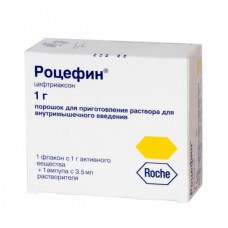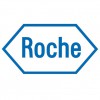Expiration date: 02/2026
Composition and form of issue:
Powder for preparation of injection solution for intramuscular injection 1 flask:
Ceftriaxone 250 mg
(in the form of Ceftriaxone disodium salt-298, 3 mg)
Ceftriaxone 500 mg
(in the form of Ceftriaxone disodium salt-596, 5 g)
Ceftriaxone 1 g
(in the form of Ceftriaxone disodium salt-1, 193 g)
solvent: lidocaine 1% solution
in bottles on 250, 500 mg or 1 g (with solvent in ampoules on 2 ml — for bottles on 250 and 500 mg and 3, 5 ml — for bottles on 1 g) in a pack cardboard 1 bottle and 1 ampoule.
Powder for preparation of injection solution for intravenous infusion 1 flask:
Ceftriaxone 250 mg
(in the form of Ceftriaxone disodium salt-298, 3 mg)
Ceftriaxone 500 mg
(in the form of Ceftriaxone disodium salt-596, 5 g)
Ceftriaxone 1 g
(in the form of Ceftriaxone disodium salt-1, 193 g)
solvent: water for injection
in bottles on 250, 500 mg or 1 g (with solvent in ampoules on 5 ml — for bottles on 250 and 500 mg and 10 ml — for bottles on 1 g) in a pack cardboard 1 vial and 1 ampoule.
Powder for preparation of solution for intravenous and intramuscular administration 1 1 flask:
Ceftriaxone 1 g
(in the form of Ceftriaxone disodium salt-1, 193 g)
in vials of 1 g in a pack of cardboard 1 bottle.
Powder for solution for infusion 1 flask:
Ceftriaxone 2 g
(in the form of Ceftriaxone disodium salt-2, 386 g)
in vials of 2 g in a pack of cardboard 1 bottle or cardboard box 143 bottles-for hospitals.
Pharmacological action:
Inhibits the synthesis of peptidoglycan cell wall of most gram-positive and gram-negative microorganisms.
Pharmacokinetics:
Well and quickly absorbed after the / m introduction and penetrates into the tissue and bio-fluids, including cerebrospinal fluid (in particular, with inflammation of the meninges). T1 / 2 — 8 hours for 24 hours after taking the therapeutic dose — the concentration in the body above the minimum inhibitory for most infectious agents. From 30 to 60% is excreted in the active form of kidneys, the rest — the liver (with bile).
Description of the pharmacological action:
Has a bactericidal effect on many gram-negative and gram-positive bacteria. Highly sensitive species are: Proteus mirabilis, Haemophilus influenzae, Neisseria gonorrhoeae, Neisseria meningitidis, Escherichia coli, Salmonella spp., Shigella spp., Klebsiella spp., Klebsiella pneumoniae, Enterobacter, indole-positive Proteus, Streptococcus viridans, Streptococcus pneumoniae. Moderately sensitive strains are: Serratia marcescens, Pseudomonas aeruginosa, Staphylococcus aureus, Listeria monocytogenes, Bacteroides fragilis, Clostridium spp., Chlamydia trachomatis. Photosensitive strains are: Pseudomonas spp. (except P. aeruginosa), Streptococcus faecalis, Mycoplasma hominis and pathogenic fungi. Resistant to most beta-lactamases and therefore acts on strains with acquired tolerance to other cephalosporins.
Clinical pharmacology:
After the symptoms disappear, the patient is treated for at least another three days. In patients with impaired renal function (normal liver function) dose can not be reduced.
Indications:
Infections of the urinary, respiratory and biliary tract, gastrointestinal tract, bones and joints, skin and soft tissues, ENT organs, reproductive system peritonitis, sepsis, meningitis, gonorrhea.
Contraindications:
Hypersensitivity (including to other beta-lactams), hepatic-renal failure.
Application for pregnancy and breastfeeding:
Not recommended during lactation (it is necessary to stop breastfeeding). Contraindicated in the first trimester of pregnancy.
Side effect:
Headache, dyspepsia, diarrhea, nausea, vomiting, stomatitis, glossitis, cholestasis, eosinophilia, leukopenia, thrombocytopenia, granulocytopenia, hemolytic anemia, increased activity of hepatic transaminases, hypercreatininemia, hypocoagulation, oliguria, chills, phlebitis, pain at the injection site, mycosis, pseudomembranous colitis, allergic reactions( eczema dermatitis, itching, urticaria).
Drug interaction:
Pharmacologically incompatible with other antibiotics.
Method of application and doses:
In/in and in / forge the.
The standard dosing regimen
Adults and children over 12 years: 1-2 g once a day (every 24 hours). In severe cases or infections, the causative agents of which have only moderate sensitivity to Ceftriaxone, the daily dose can be increased to 4 g.
Newborns (up to 2 weeks): 20-50 mg/kg body weight once a day. The daily dose should not exceed 50 mg/kg body weight. In determining the dose should not distinguish between full-term and premature infants.
Infants and young children (from 15 days to 12 years): 20-80 mg/kg body weight once a day.
Children weighing more than 50 kg are prescribed doses for adults.
In / in doses of 50 mg / kg or higher should be administered drip for at least 30 min.
Patients of senile age: usual doses for adults, not adjusted for age.
The duration of treatment depends on the course of the disease. As with antibiotic therapy, the introduction of Rocephin should continue to be sick even for at least 48-72 hours after normalization of temperature and confirm eradication of the pathogen.
Combination therapy
The experiment shows the synergism between Rocephin and aminoglycosides in relation to many gram-negative bacteria. Although the increased efficacy of such combinations is not always predictable, it should be borne in mind in severe, life-threatening infections such as those caused by Pseudomonas aeruginosa. Due to the physical incompatibility of Ceftriaxone and aminoglycosides, they should be administered separately at their recommended doses.
Dosing in special cases
In bacterial meningitis in infants and young children, treatment begins with a dose of 100 mg/kg (but not more than 4 g) 1 time per day. After identification of the causative agent and determining its sensitivity, the dose can be reduced accordingly. The best results with meningococcal meningitis were achieved with a duration of treatment of 4 days, with meningitis caused by Haemophilus influenzae — 6 days, Streptococcus pneumoniae — 7 days.
Lyme borreliosis: 50 mg / kg (highest daily dose — 2 g) for adults and children, 1 time per day for 14 days.
Gonorrhoea (caused by penicillin-producing and penicillin-producing strains): a single I/m injection of 250 mg of Rocephin.
Prevention of postoperative infections: depending on the degree of infection risk, 1-2 g of Rocephine is administered once 30-90 minutes before the operation. During operations on the colon and rectum is a well-proven simultaneous (but separate) introduction Rocephin and one of the 5-nitroimidazoles, for example Ornidazole.
In patients with impaired renal function there is no need to reduce the dose if liver function remains normal. Daily dose of Rocephin should not exceed 2 g only in cases of preterminal renal failure (Cl creatinine less than 10 ml/min). In patients with impaired liver function, there is no need to reduce the dose if kidney function remains normal.
In combination with severe renal and hepatic insufficiency should regularly determine the concentration of Ceftriaxone in plasma and, if necessary, adjust its dose.
Patients on dialysis do not require additional administration of the drug after dialysis. It is necessary, however, to control the concentration of Ceftriaxone in serum for possible dose adjustment, since the rate of excretion in these patients may decrease.
Introduction
As a rule, solutions of the drug should be used immediately after preparation.
The prepared solutions retain their physical and chemical stability for 6 hours at room temperature (or 24 hours at 2-8 °C). However, the General rule should be the use of solutions immediately after preparation. Depending on concentration and duration of storage color of solutions can vary from pale yellow to amber. Colouring of the solution does not affect the effectiveness or tolerance of the drug.
For I/m injection of 250 or 500 mg Rocephine dissolved in 2 ml and 1 g in 3, 5 ml of 1% lidocaine solution and inject deep into gluteal muscle. It is recommended to introduce no more than 1 g in one buttock. A solution containing lidocaine should not be administered in/in.
For on / in injections dissolve 250 or 500 mg of Rocephin in 5 ml, and 1 g — in 10 ml of sterile water for injection is injected slowly for 2-4 min.
The on/in infusion should last at least 30 min To prepare a solution diluted with 2 g Rocefin in 40 ml of one of the following infusion solutions containing calcium ions: 0, 9% sodium chloride 0, 45% NaCl + 2, 5% glucose, 5% glucose, 10% glucose, 5% fructose, 6% dextran in 5% glucose solution, 6-10% gidroksietilirovanny starch, water for injection. Solutions of Rocephin should not be mixed or added to solutions containing other antibiotics or other solvents, with the exception of those listed above, due to possible incompatibility.
Precautionary measures:
Caution is prescribed for patients with severe renal insufficiency and liver (requires monitoring concentrations in plasma), newborns with hyperbilirubinemia and premature babies, patients with allergies to beta-lactams — possible cross-Allergy). With long-term treatment should periodically check the cell composition of peripheral blood.
Storage conditions:
Store the prepared solution at room temperature no more than 6 h or in the refrigerator at 2-8 °C no more than 24 h.



